GE2MorF - Genetics, Evolution and Ecology of the Floral Morphology
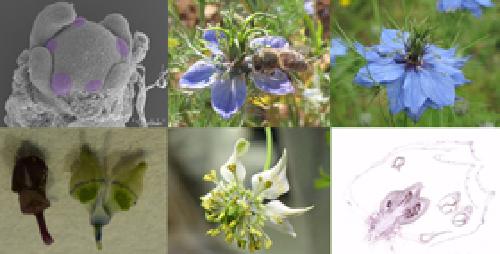
We are interested in the evolution of the floral architecture, more specifically that of the perianth, i.e. all the sterile organs involved in the protection of fertile organs and/or the attraction of pollinators. Our models of study belong mainly to the Ranunculaceae family, a member of the Ranunculales order. There phylogenetic position is very interesting for evo-devo studies because it is the first clade to diverge among eudicotyledons (APG IV, 2017). It also presents a great diversity of perianth, with organ morphologies that can be simple or elaborate (i.e., flat with a nectariferous scale, e.g., Ficaria verna or with a nectariferous spur, e.g., Aquilegia sp.). The morpho-anatomical characterization of these organs and the analysis of the dynamics of the gene networks involved in their developments represent a fundamental challenge in evolutionary biology. To reach these objectives, we mainly use Nigella damascena (commonly known as love-in-a-mist) as a study model, which is a very suitable for the production of fundamental knowledge on the evolution of floral morphogenesis. Moreover, this species opens up many opportunities to address multidisciplinary scientific projects, such as the mechanisms of pollinator attraction. We also include sustainability issues in our research projects, such as environmental management, development of agricultural practices adapted to climate change.
The GE2MorF team is also part of a network of international research collaborations on Ranunculales. We are members of the RanOmics network (10 research teams) led by Pr. Annette Becker, which brings together the world leaders in evo-devo studies on Ranunculales models. Among its members, we have long-standing collaborations with Pr. Sophie Nadot and Florian Jabbour. Our research projects are fully in line with the three research axes of the UMR GQE-Le Moulon.
Project in Axis 1
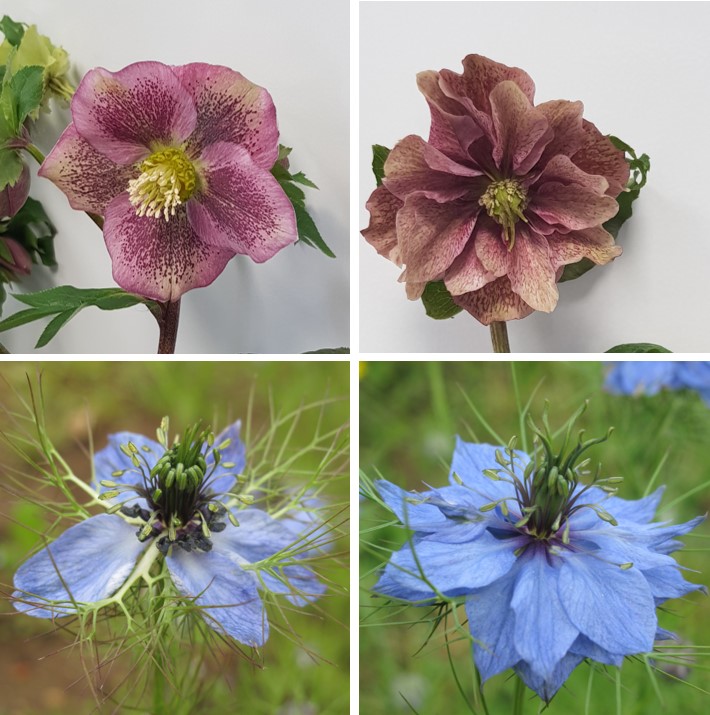
The genetic and molecular origin of perianth diversity is the main project of our team. Nigella damascena L., our preferred model, has the advantage of presenting a natural floral dimorphism with morphs with nectariferous petals [P] or without petals [T]. We took advantage of these two floral morphs to (i) access the gene network controlling the formation of petals and (ii) elucidate the mechanisms regulating the identity and morphogenesis of petals. These results and ongoing projects allow us to investigate the function and evolutionary dynamics of the genes of the petal network, including other Ranunculaceae species with more or less complex petal structures.
We are also interested in the evo-devo of nectars and spurs, the major structures involved in attracting pollinators and in the co-evolution of flowering plants with insects. We aim at analyzing the petal morpho-anatomy in order to link the latter to the evolutionary dynamics of major genes of the petal regulatory network.
Project in Axis 2
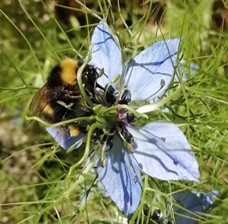
In nigella, previous studies have demonstrated the major role of nectariferous petals in attracting pollinators. The team is taking advantage of the new environment created by the recent grouping of the 3 units GQE, ESE and EGCE in the IDEEV building, to develop a collaborative project with Jean-Christophe Sandoz of EGCE, specialist in honeybee behavior. The objective of such collaboration is to better understand the signaling mechanisms involved in plant-insect pollinator interactions (funded by the Graduate School “Biosphera”).
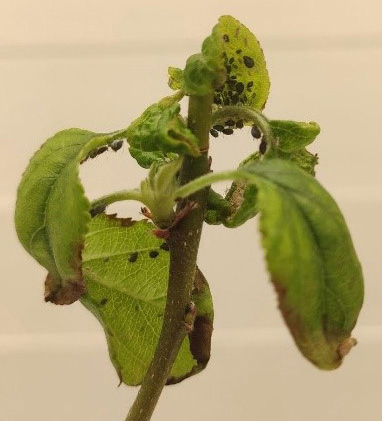
We also collaborate with Amandine Cornille, an expert in ecology and population genomics of fruit trees, who studies the impact of domestication on their adaptation to new biotic and abiotic constraints. These plants are indeed good models for understanding at the molecular level the evolutionary mechanisms of rapid responses to global changes. Building on the apple tree and aphid as models, the project aims to understand the regulation of genes, transposable elements, and the methylome involved in the responses of cultivated plants to climate change and parasitic attacks.
Project in Axis 3
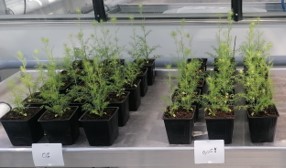
Nigella damascena is a nectariferous species that is cultivated on several continent as an ornamental plant. This species that is well-adapted to episodes of extreme heat and water stress, is also interesting for the medicinal properties of its essential oil. In the context of climate change, this species is a genetic resource with good agronomic potential either for the production of pharmacological compounds or as a pollination service plant to contribute to local increases in the diversity and abundance of pollinating insects. We aim to select Nigella lines suitable for these issues. This project is funded by the Institut Carnot Plant2Pro.
Members
- Carmine Claudot PhD student (Université Paris-Saclay)/ (INRAE)
- Natalia Conde e Silva Assistant Professor (Université Paris-Saclay)
- Ronan Dadole PhD student (Université Paris-Saclay)
- Catherine Damerval Senior Investigator Emeritus (CNRS)
- Yves Deveaux Group leader, Associate Professor (Université Paris-Saclay)
- Clémence Foulon Apprentice, Licence Pro BIB (Université Paris-Saclay)
- Nedim Jamak research technician, CDD Plant2Pro (INRAE)
- Arnaud Leclerc Greenhouse technician (INRAE)
- Julie Zalko Associate professor (Université Paris-Saclay)
Former member
Martine Le Guilloux AI CNRS (1982-2024)Publications
- Becker A., Bachelier JB., Carrive L., Conde e Silva N. , Damerval C. , Del Rio C., Deveaux Y. , Di Stilio VS., Gong Y., Jabbour F., Kramer EM., Nadot S., Pabón-Mora N., Wang W., RanOmics group. (2023) A cornucopia of diversity - Ranunculales as a model lineage. J Exp Bot, erad492
- Conde e Silva N. , Leguilloux M., Bellec A., Rodde N., Aubert J., Manicacci D., Damerval C. , Berges H., Deveaux Y. . (2023) A MITE insertion abolishes the AP3-3 self-maintenance regulatory loop in apetalous flowers of Nigella damascena. Journal of Experimental Botany, 5 (74) 1448-1459
- Damerval C. , Claudot C. , Le Guilloux M., Conde e Silva N. , Brunaud V., Soubigou-Taconnat L., Caius J., Delannoy E., Nadot S., Jabbour F., Deveaux Y. . (2022) Evolutionary analyses and expression patterns of TCP genes in Ranunculales. Front Plant Sci, (13) 1055196
- Delpeuch P., Jabbour F., Damerval C. , Schönenberger J., Pamperl S., Rome M., Nadot S.. (2022) A flat petal as ancestral state for Ranunculaceae. Front Plant Sci, (13) 961906
- Deveaux Y. , Conde e Silva N. , Manicacci D., Le Guilloux M., Brunaud V., Belcram H., Joets J., Soubigou-Taconnat L., Delannoy E., Corti H., Balzergue S., Caius J., Nadot S., Damerval C. . (2021) Transcriptome Analysis Reveals Putative Target Genes of APETALA3-3 During Early Floral Development in Nigella damascena L.. Front. Plant Sci., (12) 660803
- Galipot P., Gerber S., Le Guilloux M., Jabbour F., Damerval C. . (2021) Micro- and Macroscale Patterns of Petal Morphogenesis in Nigella damascena (Ranunculaceae) Revealed by Geometric Morphometrics and Cellular Analyses. Front Plant Sci, (12) 769246
- Galipot P., Damerval C. , Jabbour F.. (2021) The seven ways eukaryotes produce repeated colour motifs on external tissues. Biol Rev Camb Philos Soc, 4 (96) 1676-1693
- Jabbour F., Pasquier PED., Chazalviel L., Guilloux ML., Conde e Silva N. , Deveaux Y. , Manicacci D., Galipot P., Heiss AG., Damerval C. . (2021) Evolution of the distribution area of the Mediterranean Nigella damascena and a likely multiple molecular origin of its perianth dimorphism. Flora, (274) 151735
- Carrive L., Domenech B., Sauquet H., Jabbour F., Damerval C. , Nadot S.. (2020) Insights into the ancestral flowers of Ranunculales. Botanical Journal of the Linnean Society, 1 (194) 23-46
- Espinosa F., Damerval C. , Le Guilloux M., Deroin T., Wang W., Pinedo-Castro M., Nadot S., Jabbour F.. (2020) Homeosis and delayed floral meristem termination could account for abnormal flowers in cultivars of Delphinium and Aquilegia (Ranunculaceae). Botanical Journal of the Linnean Society, boaa063
- Damerval C. , Citerne H., Conde e Silva N. , Deveaux Y. , Delannoy E., Joets J., Simonnet F., Staedler Y., Schönenberger J., Yansouni J., Le Guilloux M., Sauquet H., Nadot S.. (2019) Unraveling the Developmental and Genetic Mechanisms Underpinning Floral Architecture in Proteaceae. Front Plant Sci, (10) 18
- Damerval C. , Othman WB., Manicacci D., Jabbour F.. (2018) Distribution area of the two floral morphs of Nigella damascena L. (Ranunculaceae): A diachronic study using herbarium specimens collected in France. Botany Letters, 3-4 (165) 396-403
- Citerne HL., Reyes E., Le Guilloux M., Delannoy E., Simonnet F., Sauquet H., Weston PH., Nadot S., Damerval C. . (2017) Characterization of CYCLOIDEA-like genes in Proteaceae, a basal eudicot family with multiple shifts in floral symmetry. Ann Bot, 3 (119) 367-378
- Damerval C. , Jabbour F., Nadot S., Citerne HL.. (2017) Evolution of symmetry in plants. , 1-18
- Damerval C. , Becker A.. (2017) Genetics of flower development in Ranunculales – a new, basal eudicot model order for studying flower evolution. New Phytologist, 2 (216) 361-366
- Damerval C. , Nadot S.. (2017) Letter to the 21st century botanist: “What is a flower?” 6. The evo-devo of floral symmetry. Botany Letters, 3 (164) 193-196
- Denis E., Kbiri N., Mary V., Claisse G., Conde e Silva N. , Kreis M., Deveaux Y. . (2017) WOX14 promotes bioactive gibberellin synthesis and vascular cell differentiation in Arabidopsis. Plant J., 3 (90) 560-572
- Cossard G., Sannier J., Sauquet H., Damerval C. , de Craene LR., Jabbour F., Nadot S.. (2016) Subfamilial and tribal relationships of Ranunculaceae: evidence from eight molecular markers. Plant Syst Evol, 4 (302) 419-431
- Deroin T., Damerval C. , Le Guilloux M., Jabbour F.. (2015) Floral vascular patterns of the double-flowered and wild-type morphs of Nigella damascena L. (Ranunculaceae). Modern Phytomorphology, (7) 13-20
- Jabbour F., Udron M., Le Guilloux M., Goncalves B., Manicacci D., Nadot S., Damerval C. . (2015) Flower development schedule and AGAMOUS-like gene expression patterns in two morphs of Nigella damascena (Ranunculaceae) differing in floral architecture. Bot J Linn Soc, 4 (178) 608-619
- Sauquet H., Carrive L., Poullain N., Sannier J., Damerval C. , Nadot S.. (2015) Zygomorphy evolved from disymmetry in Fumarioideae (Papaveraceae, Ranunculales): new evidence from an expanded molecular phylogenetic framework. Ann Bot, 6 (115) 895-914
- Jabbour F., Cossard G., Le Guilloux M., Sannier J., Nadot S., Damerval C. . (2014) Specific duplication and dorsoventrally asymmetric expression patterns of cycloidea-like genes in zygomorphic species of ranunculaceae. PloS one, 4 (9) e95727
- Citerne HL., Le Guilloux M., Sannier J., Nadot S., Damerval C. . (2013) Combining phylogenetic and syntenic analyses for understanding the evolution of TCP ECE genes in eudicots. PloS one, 9 (8) e74803
- Damerval C. , Citerne H., Le Guilloux M., Domenichini S., Dutheil J., Ronse de Craene L., Nadot S.. (2013) Asymmetric morphogenetic cues along the transverse plane: shift from disymmetry to zygomorphy in the flower of Fumarioideae. American journal of botany, 2 (100) 391-402
- Gonçalves B., Nougué O., Jabbour F., Ridel C., Morin H., Laufs P., Manicacci D., Damerval C. . (2013) An Apetala3 homolog controls both petal identity and floral meristem patterning in Nigella damascena L. (Ranunculaceae). The Plant journal : for cell and molecular biology, 2 (76) 223-35
- Corbi J., Dutheil JY., Damerval C. , Tenaillon MI., Manicacci D.. (2012) Accelerated evolution and coevolution drove the evolutionary history of AGPase sub-units during angiosperm radiation. Annals of botany, 4 (109) 693-708
- Becker A., Alix K., Damerval C. . (2011) The evolution of flower development: current understanding and future challenges. Annals of botany, 9 (107) 1427-31
- Hasson A., Plessis A., Blein T., Adroher B., Grigg S., Tsiantis M., Boudaoud A., Damerval C. , Laufs P.. (2011) Evolution and diverse roles of the CUP-SHAPED COTYLEDON genes in Arabidopsis leaf development. The Plant cell, 1 (23) 54-68
- Virlouvet L., Jacquemot MP., Gerentes D., Corti H., Bouton S., Gilard F., Valot B., Trouverie J., Tcherkez G., Falque M., Damerval C. , Rogowsky P., Perez P., Noctor G., Zivy M., Coursol S.. (2011) The ZmASR1 protein influences branched-chain amino acid biosynthesis and maintains kernel yield in maize under water-limited conditions. Plant physiology, 2 (157) 917-36








